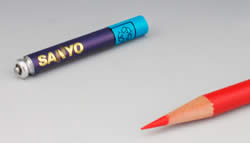Sanyo Pin Type Lithium Ion Batteries
 Sanyo Press Release
Sanyo Press Release
SANYO Develops and will Start Mass Production of the Industry’s Smallest “Pin Type Lithium ion Batteries”!
This new thin design will contribute to even smaller mobile devices
Tokyo, March 16, 2005—-SANYO Electric Co., Ltd. (SANYO), the world’s leader of small-sized rechargeable batteries, announced the development and the start of mass production of “pin type Lithium ion batteries”, a thinly shaped rechargeable battery.
Following the recent advancement of mobile devices, the demands for batteries which enable design flexibility and further compactness of mobile devices, while maintaining the excellent features of
Lithium ion batteries such as “high energy density”, “high safety” and “high voltage”, have increased year after year. To meet these market needs, SANYO has developed the industry’s smallest*1 “pin type Lithium ion batteries (UR655)” and will start mass production.
SANYO will sell a new model (UR655), in the summer of 2005 and will expand the adoption of “pin type Lithium ion batteries” to other models as well, to create new application markets.
Main features
1. Reduced the size (about half the volume of AAA batteries and one-quarter of AA batteries) while maintaining great battery characteristics by adopting original new battery structure!
SANYO has succeeded in making the diameter of “pin type Lithium batteries” smaller by uniting a battery terminal and a shaft which is used for the rolling up process of battery polar plates and
separators. This structure enables minimization of capacity loss and dramatically reduced the battery size (about one-quarter*4) compared to conventional lithium ion battery technology. The shaft has functions of both the negative terminal and the battery cap which helps to simplify battery components.
Moreover, “pin type Lithium ion batteries” inherit Lithium ion batteries’ excellent features such as “high energy density” and “high rate discharge”, by adopting the same polar plate structure and
composition of cylindrical Lithium ion batteries. Such excellent features are difficult to realize with coin type batteries. SANYO expects expansion of “pin type Lithium ion batteries” to many kinds of
applications such as MP3 players which require high energy density, bridge batteries for laptop computers and wireless communication equipment like wireless headsets which require a high rate
discharge.
2. Able to reduce the weight and volume of mobile devices by adopting aluminum alloy case andsimplifying the protection circuit!
Batteries for small mobile devices are required to be compact, lightweight and highly reliable.
SANYO adopts not an aluminum laminated film but an aluminum alloy case which has been used for prismatic Lithium ion batteries, which keeps safety equivalent to that of conventional Lithium ion batteries.
Using “pin type Lithium ion batteries”, it is possible to simplify the protection circuit while maintaining reliability as well as reducing the weight of the battery. As a result, “pin type Lithium ion batteries” enable mobile devices to be smaller, lightweight and highly reliable.
In terms of volume, “pin type Lithium ion batteries” are about half the volume of AAA dry cell batteries and about one-quarter of AA dry cell batteries. Thanks to its original shape, it is possible to set “pin type Lithium ion batteries” on the surface of the circuit board, on the edge of the circuit board and even in open spaces where prismatic Lithium ion batteries and Lithium polymer batteries are incapable of being set. SANYO believes that “pin type Lithium ion batteries” dramatically enhances design flexibility of small mobile devices.
New Model Specifications (UR655)
Product Lithium ion Battery
Configuration Pin type
Model Number UR655
Battery Capacity (guarantee performance) 120 mAh
Charging Voltage (maximum) 4.2 V
Size 6.8(diameter)mm X 55(height) mm
Weight (maximum) 5g
Volumetric Energy Density 243 Wh/l
Gravimetric Energy Density 89 Wh/kg
Start of Shipment Summer of 2005
Initial Month Production 100,000 Units
